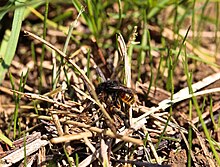Bicolored snail shell bee
| Bicolored snail shell bee | ||||||||||||
|---|---|---|---|---|---|---|---|---|---|---|---|---|

Two-colored snail-shell bee ( Osmia bicolor ) |
||||||||||||
| Systematics | ||||||||||||
|
||||||||||||
| Scientific name | ||||||||||||
| Osmia bicolor | ||||||||||||
| Cabinet , 1781 |
The two-colored snail-shell bee ( Osmia bicolor ) is a solitary wild bee species of the genus Osmia from the group of mason bees (family Megachilidae). The species was wild bee of the year 2013 in Germany .
features
The abdomen of the two-colored snail-shell bee is rust-red, the head and chest are black. The female bees are eight to ten millimeters tall. The drones are smaller and paler. As with all Megachilidae, the females have thick hairs on the underside of the abdomen with which they transport pollen.
Similar species
Other species with two-tone drawings are for example the horned mason bee O. cornuta and the stone bumblebee Bombus lapidarius .
Occurrence
The two-colored snail-shell bee occurs from southern northern Europe to northern southern Europe , in Germany in all federal states except Schleswig-Holstein . In the Alps it can be found at heights of up to 2000 meters.
Way of life
At the beginning of March, the males of the two-tone snail shell bee hatch and start looking for suitable snail shells . Two weeks later, the females hatch and from March / April usually lay one egg (rarely up to four eggs) in a snail shell. Be used Schneckenhäuser species grove snail ( Cepaea nemoralis ), Rib Bänderschnecke ( C. vindobonensis ), C. hortensis , Arianta arbustorum , Bradybaena fruticum and snail ( Helix pomatia ). Before laying eggs, the bees carry pollen and nectar into the selected snail shell to feed the brood. Osmia bicolor can use pollen and nectar from many different plants. Then the animals seal their snail shell with a mortar made of chewed pieces of leaf mixed with stones and crumbs of earth, turn the shell so that its opening faces the ground, and camouflage it with blades of grass and needles from trees. Usually a bee creates five to seven such nests and dies in early July at the latest. The offspring hatch in the following spring. The two-colored snail-shell bee is therefore univoltin .
Synonyms
The bee is also known by the following names:
- Apis rustica Geoffroy , 1785
- Apis fusca Christ , 1791
- Apis fuscescens Villers , 1789
- Apis hirundinaria Christ , 1791
- Osmia pyrenaea Lepeletier , 1841
- Osmia fusca Christ , 1791
- Osmia rufitarsis Smith , 1879
- Osmia monachiensis beach , 1917
Web links
Individual evidence
- ↑ Wild bee of the year 2013 - Wild bee cadastre (PDF file on wildbienen-kataster.de )
- ↑ Two-colored snail-shell mason bee - Osmia bicolor - Bavaria's native inhabitants. Retrieved February 14, 2019 .
- ^ A b Paul Westrich: The wild bees of Germany . Stuttgart, ISBN 3-8186-0123-2 , pp. 597 .
- ↑ Osmia bicolor (Cabinet, 1781) | BWARS. Retrieved February 14, 2019 .




